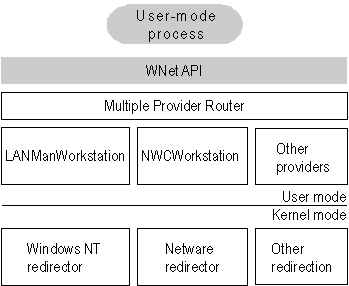
For each additional type of network (NetWare, VINES, or some other), you must install a component called a provider. The provider is the component that allows a Windows NT computer to communicate with the network. Windows NT includes a provider for the Windows NT network. It also includes the Client Service for NetWare with Windows NT Workstation and the Gateway Service for NetWare with Windows NT Server, with which a Windows NT computer can connect as a client to a NetWare network. Other provider DLLs are supplied by the appropriate network vendors.
From the application viewpoint, there are two sets of commands that can cause network traffic—uniform naming convention (UNC) commands and WNet commands.
UNC is a method of identifying a shared resource on a network. UNC names start with two backslashes followed by the server name. All other fields in the name are separated by a single backslash. Although it's enough to simply specify the servername to list a server's shared resources, a full UNC name is in this form:
\\server\share\subdirectory\filenameWNet is part of the Win32® API and is specifically designed to allow applications on Windows NT workstations to connect to multiple networks, browse the resources of computers on those networks, and transfer data between computers of various networks. File Manager, for example, uses the WNet interface to provide its network browsing and connection facilities.
As shown in Figure 1.10, the provider layer spans the line between kernel and user modes to manage commands that may cause network traffic. The provider layer also includes two components to route UNC and WNet requests to the appropriate provider:

Figure 1.10 Provider Interface Components
Note I/O calls, such as Open, can contain both an UNC name and WNet calls.
The MUP is a kernel-mode component whose job is to locate UNC names. When an application sends a command containing UNC names, MUP routes each UNC name to one of the registered UNC providers, including LanmanWorkstation and any others that may be installed. When a provider indicates that it can communicate with the server, MUP sends the remainder of the command to the provider.
When applications make I/O calls that contain UNC names, the MUP directs them to the appropriate redirector file system driver. The call is routed to its redirector based on the handle on the I/O call.
Through the MPR, Windows NT provides an open interface that enables consistent access to third-party network file systems. The key to the MPR is that all file systems, regardless of type and physical location, are accessible through the same set of file system APIs.
Applications, including File Manager, make file system requests through the Windows NT Win32 API. The MPR ensures that requests are directed to the proper file system. Local file requests are sent to the local disk, remote requests to Windows-based servers are sent to the proper server by the Windows redirector, requests to NetWare-based servers are handled by the NetWare Client for Windows NT and sent to the NetWare server, and so on.
Because applications access all types of files through a single set of APIs, any application can access any kind of server without affecting the user.